|
|||||||||||||||||||||||||||||||||||||
|
|
Solar Pannels | ||||||||||||||||||||||||||||||||||||
|
SWIMMING POOLS-SPORTS PLANTS-TOURISTIC FIELD
The use of solar energy for hot water heating and summer swimming pools (public or private ones), is the cheapest system. Indeed, you can use tube collectors without glass cover, less expensive and easier to install. Another field where you can use solar energy is the touristic one (swimming-pools, beaches, football fields, tennis courts ect.). The demand of hot water for the guests is met by the building of large solar plants, thanks to the availability of huge areas to cover that these places offer. 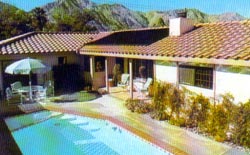
Plant for beaches and showers 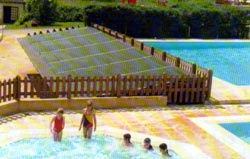
ACS Solar plant and swimming-pool heating 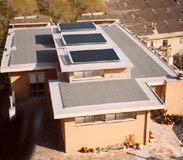
Hot water plant for sports centre 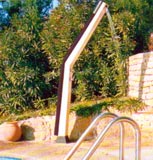
Solar shower PHOTOVOLTAIC PANELS ON ROOFS The most common applications of the photovoltaic system are the installations on flat roofs. The availability of large flat surfaces (Italian buildings) allows to arrange considerable quantities of electric energy. The maximum radiation is obtained at our latitude (Italy) orienting the plant southwards and inclining the panels of almost 30°. The photovoltaic plants installed on roofs of schools, firms or factories not only demonstrate the high sensitivity of the owners to environmental problems, but they underline the choice giving a smart look to the site. You can realize an integration to the roof, either for the photovoltaic or for the thermic solar system, if you have a steep roof. The integration to the roof is not only the best architectural and aesthetical solution, but it also offers many advantages to the impermeabilization of the cover. 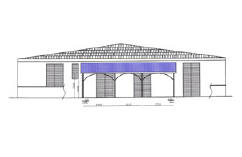
Scheme of solar energy output 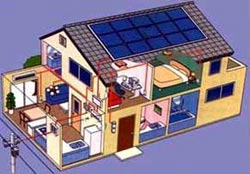
Project of photovoltaic roof 
Stand for photovoltaic generator 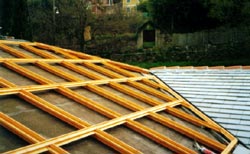
Integrated plant on a cover in course of construction PHOTOVOLTAIC PANELS ON FACADES Photovoltaic Panels can be integrated either on roofs or on building facades. There are several types of photovoltaic modules for architectural integration on the market: for continuous facades, integration into facades, sunbreak barriers, railings. This wide range offers many advantages, not only from the energetical point of view, but also for architectural solutions of great aesthetical value. The most advanced systems are made of hardened, high transparency glass. Applied to vertical surfaces, they combine energetical savings and a good natural lighting. 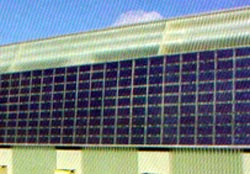

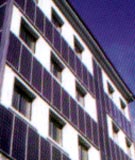
Integrated plants on facades HOT WATER PLANTS FOR DOMESTIC USE (ACS) The system uses solar energy to produce hot water for indoor use. The plant can be a “natural circulation” or a “forced circulation” one. In the natural circulation system there is no need to pump the fluid, since the water accumulation tank is located on the top of the solar collector: the fluid rises hit by the sun in a natural way, to release the accumulated hit to the water in the tank. Such a system is the cheapest one, but if located on the roof it produces a considerable environmental impact. On the contrary, the forced circulation system foresees to set the accumulation tank in the boiler room, a circulation pump in the panels, and a control power-station which will regulate the panel or the boiler working, according to the difference of temperature showed up by two probes (one in the panel, the other in the accumulation tank).The forced circulation system offers several architectural solutions, since it can be integrated in steep roofs, on penthouses or it can be located on flat structures using only the collector (only outdoors). The solar systems for the production of hot water for domestic use can be integrated in condominiums with centralized plants, offering many chances of savings on consumes. 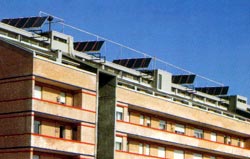
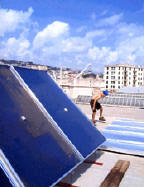
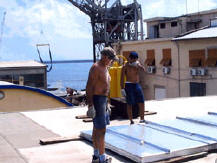
PLANTS OF HOT WATER FOR DOMESTIC USE (ACS) AND HEATING This kind of plants called “combined” foresees the use of the solar panels to provide either for hot water for domestic use or thermic energy in winter. The technical difference of this plant is only in the accumulation tank which contains a smaller tank inside. The latter contains the water belonging to the circuit of hot water for domestic use, while the rest of the water is connected to the circuit of the house heating. The combined plants can be connected to the traditional gas or oil boilers, but also to wood boilers and biomass systems. However, to integrate the solar plant to the house heating the plant needs to have radiant panels (on the walls or on the floor), which using low temperatures allow the most efficiency of the collectors. The savings obtained, including the heating expenses, range from 40% to 60%. 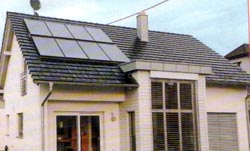
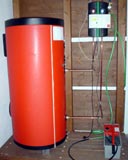

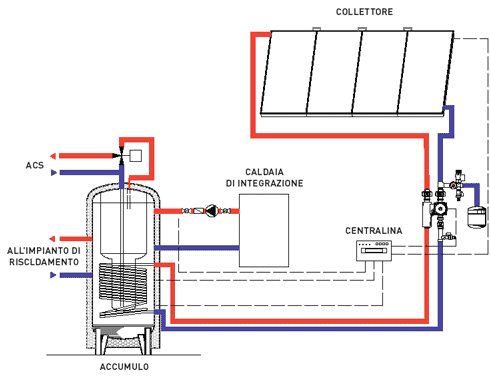
Please download: pannelli solari.pdf
|
|
|||||||||||||||||||||||||||||||||||


